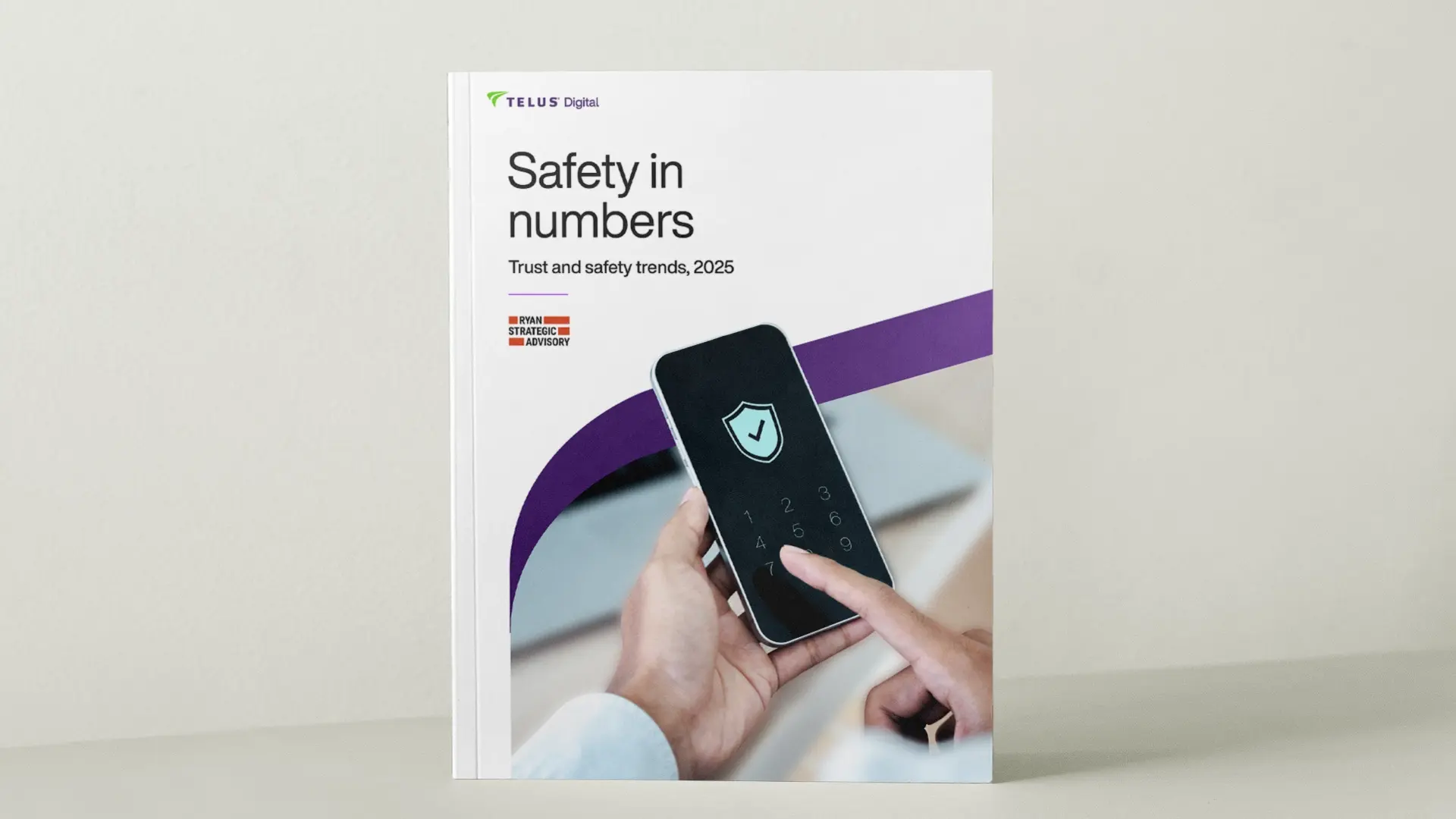Strengthening platform integrity: Best practices for digital community safety

Today’s digital communities shape culture, influence economies and define brand perception. But without strong safety foundations, they can quickly become breeding grounds for harm, misinformation and mistrust. Building that trust starts with creating environments where users feel protected and confident that the platforms they use are acting in their best interests.
This is the goal of digital community safety. It brings together the people, policies and technologies that keep online spaces secure and inclusive. When platforms treat safety as a strategic priority, the benefits extend far beyond user protection: trust drives engagement, and engagement fuels growth. In the digital economy, trust is the true currency, and community safety is how organizations earn and keep it.
How does digital community safety differ from traditional content moderation?
While content moderation plays an important role in identifying and removing harmful material online, digital community safety goes further. It considers the entire ecosystem of interactions — how rules are written, how users are supported and how emerging risks are managed — to prevent harm before it happens and sustain healthy engagement over time.
A strong online community safety framework spans several interconnected disciplines:
- Content moderation and ad review: Ensuring that text, images and advertisements align with platform policies and community values.
- Account integrity and security: Detecting fake profiles, coordinated manipulation and account takeovers.
- Child and vulnerable user protection: Safeguarding at-risk groups through proactive detection and intervention mechanisms.
- Fraud detection and prevention: Identifying and blocking deceptive activities such as scams or financial manipulation.
- User education and empowerment: Giving members the tools and knowledge to manage their online experiences responsibly.
Together, these practices form the foundation of digital trust. They protect users from harm while strengthening the credibility and resilience of the platforms themselves.
Best practices for designing online community safety programs
Building a safe and sustainable community requires both foresight and flexibility. Because every platform faces different risks, there’s no single formula for success. However, several key questions can help guide the design of a strong online community safety program.
1. How can organizations holistically design safety policies and processes?
Safety starts with clarity and alignment. A strong digital community safety program depends on clear standards, transparent communication and unified execution across every function that touches the user experience. Organizations should consider the following tips to ensure they take a structured, collaborative approach to policy and process design.
- Co-create policies with diverse stakeholders: Involve users, advocates, researchers and external experts when defining or refining safety guidelines to ensure they reflect lived experiences and cultural nuance.
- Establish transparent governance frameworks: Publish clear explanations of what is and isn’t allowed, and communicate the reasoning behind policy decisions to strengthen community understanding and trust.
- Align safety objectives across teams: Bring together content moderation, trust and safety, product and legal groups through shared KPIs and regular working sessions to ensure consistent enforcement and communication.
- Localize and contextualize policies: Adapt global standards to local regulations, languages and cultural norms to maintain both compliance and community relevance.
- Design flexible workflows: Build processes that can scale and adjust quickly when emerging risks or public events require rapid policy shifts or enforcement model changes.
2. How can platforms prevent harm proactively?
The strongest safety programs look ahead. They anticipate risk instead of reacting after harm occurs. By combining predictive data models with agile workflows, platforms can identify and address potential threats before they escalate. Organizations should focus on several key practices:
- Predictive monitoring and risk modeling: Use behavioral analytics and data science to detect early signals of harassment, misinformation or coordinated manipulation.
- Scenario-based risk testing: Simulate potential incidents to evaluate response speed, escalation paths and communication clarity under pressure.
- Continuous policy evolution: Regularly update safety guidelines to reflect emerging behaviors, cultural nuances and new threat types.
- Cross-functional feedback loops: Create channels for moderators, data analysts and policy teams to share insights that improve rules and response frameworks.
- Real-time collaboration tools: Connect trust and safety teams with engineers to accelerate policy updates, model retraining and feature-level interventions.

From reactive to proactive: Rethinking risk in the digital age
Join trust and safety experts from TELUS Digital and Everest Group for a discussion on how enterprises can update their risk management strategies to stay ahead of evolving threats.
3. Why is combining human expertise with AI essential for online community safety?
Technology enables scale, but people provide context. The most effective digital community safety programs combine automation with human expertise to ensure decisions are both accurate and empathetic. In fact, according to TELUS Digital’s Safety in numbers report, across key trust and safety functions — including fraud detection, know your customer (KYC), content moderation and ID verification — on average, nearly half (49%) of enterprise leaders reported using a combination of human expertise and technology-based solutions.
When AI and human reviewers work in concert, platforms can respond faster and more fairly to evolving risks. For effective human-AI collaboration, leaders should:
- Blend automation with expert judgment: Use AI to surface high-risk content and patterns, then rely on trained reviewers to assess nuance, intent and cultural context.
- Invest in continuous AI training: Regularly retrain detection models using diverse, high-quality data to reduce bias and improve precision across languages and content types.
- Prioritize human oversight for edge cases: Ensure sensitive or ambiguous cases are reviewed by human moderators, not left to algorithms alone.
- Monitor for bias and fairness: Establish checks and audits to identify unintended bias in both AI systems and human decision-making.
- Support reviewer well-being: Protect the mental health of moderation teams through counseling access, rotation schedules and exposure mitigation tools.
4. How can users be empowered to take part in maintaining safety?
Safety works best when it’s shared. The most resilient communities give users the tools, education and agency to help maintain a positive environment. Empowerment builds trust, encourages accountability and fosters a sense of shared responsibility for community well-being. It also helps reduce the enforcement burden on internal teams. Platforms can put empowerment into practice by:
- Offering self-moderation tools: Provide options like muting, blocking, filtering and customizable safety settings so users can control their own experience.
- Making reporting easy and responsive: Design intuitive reporting flows and ensure follow-up communication so users know their concerns are acknowledged and acted upon.
- Educating through in-product guidance: Embed short, practical resources on topics like respectful communication, misinformation awareness and digital citizenship.
- Supporting at-risk groups: Offer specialized help, such as escalation pathways or dedicated safety contacts for users facing targeted harassment or other threats.
- Encouraging positive participation: Reward constructive engagement and highlight model behaviors that reinforce a culture of respect and inclusion.

Safety in numbers: Trust and safety trends, 2025
Explore trust and safety trends for 2025 from a survey of 819 enterprise leaders. Gain insights on fraud detection, KYC, content moderation and ID verification.
5. How can platforms use transparency and metrics to build trust?
Accountability is the foundation of trust. Platforms should not only enforce safety, they need to show their work. Transparent reporting and measurable outcomes help communities see progress, reinforce credibility with regulators and partners, and create a feedback loop for continuous improvement. Platforms can strengthen accountability through practices such as:
- Publishing regular transparency reports: Share data on content removals, appeals, enforcement rates and safety incidents to demonstrate consistency and fairness.
- Tracking clear performance metrics: Measure success through indicators like reduced harmful content, faster resolution times, improved user trust scores and higher advertiser confidence.
- Engaging in open communication: Explain how policy decisions are made and provide timely updates when major changes or incidents occur.
- Benchmarking and auditing performance: Use internal and third-party assessments to evaluate policy effectiveness, model accuracy and procedural fairness.
- Closing the feedback loop: Turn lessons from transparency data into policy updates, training improvements and better user communication.
Building trust through partnership
The principles behind digital community safety are simple, but execution requires significant expertise, scale and coordination. As digital platforms expand across markets, leaders face growing pressure to anticipate harm, meet compliance standards and maintain user trust — often with limited resources and rising operational demands.
Findings from the aforementioned Safety in numbers report underscore just how difficult that balance can be. 39% of business leaders identify the availability of human resources and technical expertise as one of their biggest challenges in maintaining a safe and secure digital environment, while 44% cite compliance with government regulations and industry standards as a major barrier. But platform operators can rest assured they are not on their own. “Customer experience providers are well positioned to ease those pressures by offering the expertise, people and technology to scale trust, safety and security operations as needed,” wrote Peter Ryan, president and principal analyst at Ryan Strategic Advisory.
The challenges in earning and maintaining trust are never static. They evolve alongside technology and customer expectations. Long-term success depends on finding the right balance between building internal capability and leveraging external expertise.
At TELUS Digital, we help organizations do both — bringing together people, process and technology to protect what matters most: your customers, your community and your credibility. Through our comprehensive Platform Integrity Solutions, our clients gain:
- Access to global multilingual talent at scale.
- A partner ecosystem of leading AI and automation technologies.
- Lower risk associated with technology investment and compliance.
- The ability to adapt to evolving threats while managing operational cost.
- Cultural and contextual expertise that strengthens decision-making and response accuracy.
Choose a partner that understands trust is the foundation of every lasting digital relationship. Reach out to our team of digital community safety experts today.




